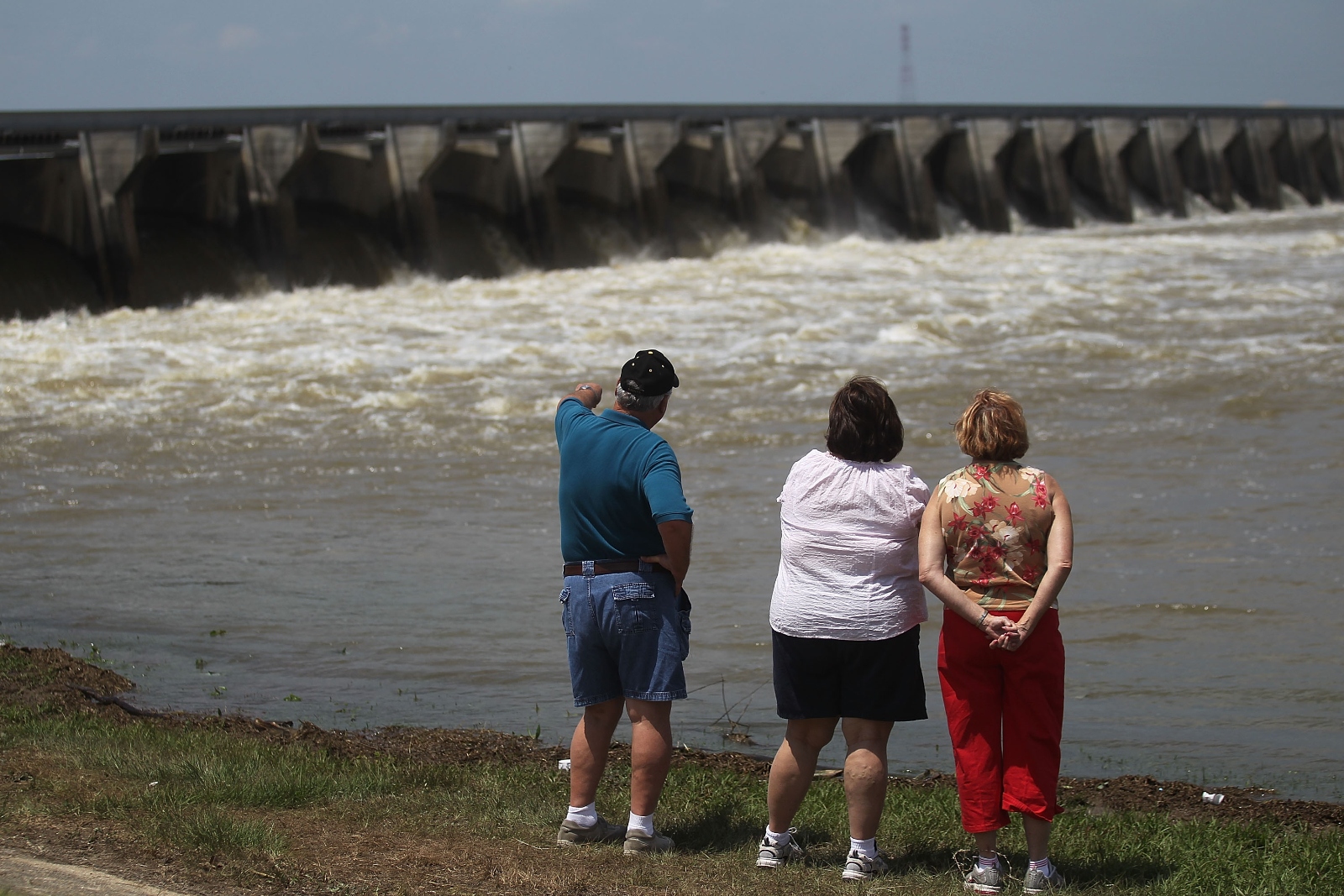In an often-excerpted passage from his memoir, Life on the Mississippi, Mark Twain describes how his perceptions of the Mississippi River changed after he spent months piloting a steamboat up and down its muddy length. “The face of the water, in time, became a wonderful book,” he said, allowing him to read the bends and eddies that meant nothing to his passengers. But the tragedy of this “valuable acquisition” was that “the romance and the beauty were all gone from the river.”
“All the value any feature of it had for me now was the amount of usefulness it could furnish toward compassing the safe piloting of a steamboat,” he wrote.
Even for those of us who will never pilot a steamboat, there is a vestigial lesson in this passage about how we perceive and talk about the environment. A body of water like the Mississippi River is something we experience with our eyes, ears, and noses, and it is in large part because of its beauty that we want to protect it. But it also has a specific human history — the river runs between artificial levees, or provides conveyance to ships carrying oil, or drains toxic runoff from factory farms.
In his fascinating new book, The Great River, the writer Boyce Upholt tells the story of the Mississippi not through the eddies and mudflats Twain passed in his steamboat, but through the stories of men who have sought to master the river for well over two centuries. Ranging across thousands of miles, he demonstrates how the United States has deformed and manipulated one of the world’s largest watersheds in the short-sighted service of economic development, often with catastrophic, unintended consequences. If Twain read the river as a book, Upholt gets more specific and reads it as a tragedy wrought by colonial hubris.
This focus on the people who carved and dredged the river for their own ends, rather than on the wilds of the river itself, produces a story that has profound lessons for coastal cities and western deserts as well as those who live in the river’s great watershed.
The most interesting question, Upholt argues, is not how the Mississippi River will fare in a changing climate, but what the history of that river tells us about how the rest of us will fare. In reviewing how “engineers worked to tame this god,” he rings an alarm about other efforts to control the flux of nature. For all our expertise and prowess, he argues, we are little more powerful than the boat passengers Twain mocked as blind to the river’s ways.
The first section of the book recounts the centuries that preceded this effort of domination. Upholt explores a growing body of archaeological research about several Indigenous societies that rose and fell along the Mississippi many hundreds of years before European settlers arrived, including one city, Cahokia, in modern-day Illinois, which housed more than 10,000 people around a central pyramid more than a hundred feet high. He contemplates the cosmic purpose of earthwork mounds like the ones in Poverty Point, Louisiana, which represent “Indigenous knowledge encoded in the land,” telling a story in which “a flood is not a catastrophe but an asset.”
Once the colonists arrive and President Thomas Jefferson sends them rampaging out into the Midwest, Upholt swings up and down the main stem of the river and along its major tributaries, the Missouri and the Ohio, describing how fur traders speared their way downstream in “keelboats [that] hugged the inner bends of the river’s curves,” fortified by “whiskey chased by a cup of river water.” Upholt announces at the start of the book that he won’t proceed in a strict chronological order, which is understandable enough since his book isn’t a traditional work of history, but his attempts to toggle backward and forward in time as well as between various tributaries can often leave the reader feeling lost.
The book hits its narrative stride, however, once Upholt introduces the Army Corps of Engineers, the federal agency that has controlled the river for almost two centuries. Since the 19th century, the Corps has spent untold billions of dollars to dredge, levee, dam, undam, channelize, divert, reroute, and re-reroute the river, attempting to control flooding and facilitate navigation for freight. This audacious effort to tame Mother Nature has achieved a degree of success that could most charitably be described as middling, and some of the best sections of the book are those in which Upholt describes the many levee and dredge projects the Corps has built against the better judgment of river experts, as well as common sense.
The squabbling engineers who have led the Corps, often hapless but always unfailingly self-serious, are the closest that Upholt gets to main characters, and their stories function as parables about the relationship between the U.S. and the environment it sought to colonize and reshape. The most famous of these was the contest between James Buchanan Eads, a brilliant civil engineer who advocated making space along the river’s banks for its water to flow and flood, and Andrew Humphreys, an Army general who advocated sealing most of the river off with man-made levees. Humphreys won the debate, with catastrophic results: In 1927, as the Corps of Engineers was finalizing its levees along the lower river, a massive flood burst through them and inundated much of Louisiana and Arkansas, killing 500 people and displacing hundreds of thousands more.
A more sympathetic character is Harold Fisk, an Army Corps cartographer who designed beautiful maps of the river’s vestigial pathways, showing how it had meandered back and forth across the heartland in the centuries before the Corps walled it off — one such map adorns the cover of Upholt’s book. Fisk’s now-legendary ribbon map “highlighted rather than obscured the wildness of the Mississippi,” and in the process discovered that the river was on the verge of cresting its banks in Louisiana and rushing southwest away from New Orleans, which would have left the city high and dry.

The pinnacle of the book is when Upholt visits the Old River control system, which was designed to hold the river in place and prevent Fisk’s prophecy from coming true. As he approaches the site, Upholt sees “concrete wing walls flare outward, funneling water toward a series of five steel gates” held in place by giant beams, and then “just upstream a second line of gates, six times longer, looms over a patch of batture … from a concrete catwalk built along the confluence, the river looked like a varicose vein … so swollen that it was ready to pop.”
It’s hard to comprehend the modern Mississippi until you’ve seen this structure. Its hubris typifies the destructive human effort Upholt is trying to depict throughout the book, and holds a lesson for regions and nations attempting to tackle the threat of climate change. If the world’s wealthiest and most powerful nation struggled to tame nature before the Earth warmed by a degree and a half, it does not bode well for its efforts to fend off sea level rise with concrete walls or solve drought problems by constructing more dams.
But the solution, as Upholt makes clear in the end, isn’t just to tear everything down, to insist on seeing the river as a pure manifestation of nature. Rather, he points us back to the Indigenous earthworks that preceded colonization, relics of a society that tried to live with the rhythms of a flood-prone river rather than change those rhythms to suit human needs, finding a harmony between Twain’s two ways of seeing the Mississippi.
“This river has never been alone,” Upholt writes after seeing an earthwork in Louisiana near a village of the Grand Bayou Atakapa-Ishak/Chawasha Tribe. He goes on to describe the half-submerged earth structure as “a monument … not to the beauty of empty nature, but to the possibility of a human connection”; rather than a “celebratory” structure, he sees the mounds as “insurance, anchor amid the chaos. They provide a lesson in how to respect nature without seeing it as something separate from human life.”
In the matter of climate change, an area where politicians often appeal to the ferocious power of nature and to our ability to right the course of the Earth itself, it’s a point well taken. To really achieve sustainability, on the Mississippi or elsewhere, we’ll have to give up some amount of control.




